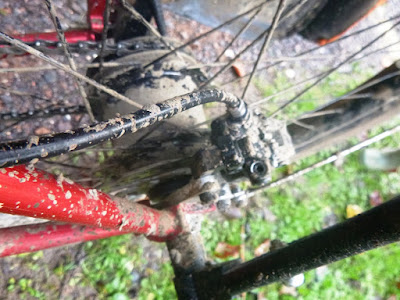EMWC - Reverse Osmosis - 5 Stage - Review - Intro
First off if you are buying this to treat tap water in the UK don't bother. Tap water in the UK is the most highly regulated in the world, in terms of quality. Depending on where you live you may be lucky enough to get mineral water out of you tap for free!
Residents of Portsmouth for example get beautiful calcium rich chalk aquifer water out of their taps. And the Drinking Water Inspectorate place strict limits on any nasties full stop. Do not bother treating mains tap water.
If you however use borehole water that is contaminated with heavy metals, pesticides or other then please read on . . . .
 |
| Takes up Most of Room Under Sink - Not a lot of room for Washing Up Liquid |
EMWC - Reverse Osmosis - 5 Stage - Review - Cost
The East Midlands Water Company sells well priced reverse osmosis units, at around the £150 mark at the time of buying. This is pretty cheap considering how complicated the unit is. However, just like buying a cheap printer, you could expect to make up for it with the cost of the cartridges. The 5 filters in the units at present are around £60 to replace, although you can order extra for not much money with initial purchase.
Bearing in mind the unit does not work the cost even if £1 would be too high.
EMWC - Reverse Osmosis - 5 Stage - Review - Quality
This worries me. I am not saying that the RO unit does not function, but the connections between filters are numerous and the the fitting are small and do not inspire confidence.
The unit operates at mains pressure! So small screw fit plastic connectors make be worry a bit. If one of these "popped off" there would be £1000s of damage done in just a few hours. Other higher cost system feature much more robust connectors and less of them.
 |
| Plastic Fittings do not Feel Very Sturdy |
Like I say I am sure it is fit for purpose, but this is a mains pressure system, and as such could be conceived as a bit flimsy.
The instructions that come with the kit are OK, but a bit more details wouldn't go amiss. Also I did not have enough inserts to put in all the pipe ends. Which was a bit annoying, how much does an insert cost 1p? And I was short. The fitting for the top of the pressure vessel will not seal with PTFE tape, so get a role of that prior to fitting. Again they could include roll of this (50p), you need it for fitting.
EMWC - Reverse Osmosis - 5 Stage - Review - Fitting Tips
Fitting is fairly simple. But any mistakes will lead to much damage from leakage so this ups the stakes a bit, it is not an enjoyable process knowing the risks are so high. Especially considering the flimsy nature of the connectors. For fitting you will need:
- Drill with c.12mm drill bit - To make hole in sink for tap.
- File Possibly - To enlarge hole in sink.
- Smaller drill bit - for fitting waste pipe
- Some silicone to seal waste pipe, if not using kit (optional extra)
- Screws and screwdriver for mounting inside cupboard
- Sharp knife and chopping board to cut pipes to length
- Adjustable spanner for tap fitting.
- PTFE Tape to seal tank threads
 |
| PTFE Around Tank Thread |
It took me around 3 hours. Although the last hour I was also cooking tea at the same time.
EMWC - Reverse Osmosis - 5 Stage - Review - Taste
The water tastes pretty flat, this is to be expected as you are pretty much drinking distilled water. Mineral filters are available to the put the minerals back in before you drink it. I have not done any analysis on the water to test how effective the treatment is.
 |
| Lots of Tubes! |
EMWC - Reverse Osmosis - 5 Stage - Review - Conclusions
This is certainly is as very cheap option for those wishing to treat water to a high state of purity, however the fittings do not inspire confidence.














































